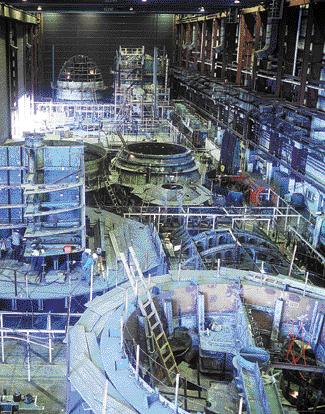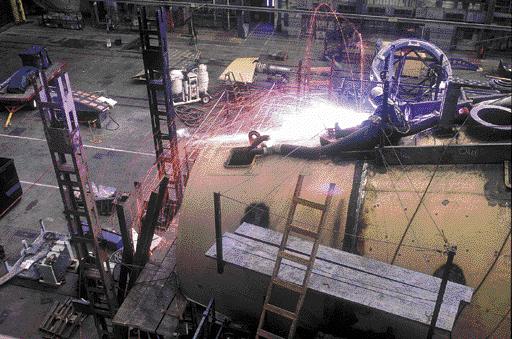
9 minute read
Texas keel-laying
by JOC Michael Foutch, USN, with information provided by Northrop Grumman Newport News
U S S CONSTRUCTIO Heralded by First Lady, Senior Navy Leadership
Advertisement
As construction continues on USS
Virginia (SSN-774), the next submarine of her class marked an important construction milestone in a ceremony 12 July at Northrop Grumman Newport News.
First Lady Laura Bush authenticated the hull of Texas (SSN-775) by scrawling her initials in chalk on a steel plate, so they could be incised with welding rod and affixed to what will be the keel of the ship. Referring to the advanced design of the Navy’s newest class of fast-attack submarines, Mrs. Bush, the ship’s sponsor and a native of Midland, Texas, smiled and joked that “Texans love to brag – if something is newer, bigger and better, then it must be from Texas.”
More than 200 guests, including a large g roup of shipyard workers, listened to a host o f Navy and political leaders laud the significant effort already made tow a rd building the ship.
The First Lady described the submarine’s namesake as a land of heroes, legends, and great adventures. “And Texas is the land of the cowboy, an all-American fellow who is polite and slow to anger but who also has an iron fist and steel-toed boots” – attributes she credited not only to Texans but also to all Americans. “I believe that spirit will be built into the core of this ship and its crew,” she added. “In the Texas vernacular, this submarine will be bigger and better than anything, anywhere, and it will be manned by the h e roes and legends of the United States Na v y.”
The Virginia-class’s advanced technology will bring with it an increase in firepower, m a n e u ve r a b i l i t y, and stealth. These submarines are 377 feet long, will be able to stay submerged for up to three months at a time, and are capable of underwater speeds of more than 25 knots. They are designed to be multi-mission capable, with the most advanced levels of stealth and new systems for intelligence gathering and deploy i n g Naval Special Warfare forces in littoral areas. The new class also will serve as the stealthy platform of choice for ISR, strike, covert mining, SOF, ASW, and Anti-Su rf a c e Warfare (ASUW) missions.
“The keel laying is the first milestone –authenticating the foundation – of this ship,” said Thomas Shievelbein, President, Northrop Grumman Newport News. “But the real foundation is the shipbuilders who build it and the men who board it. This is a celebration of their skills and dedication.”
“ Four centuries ago, sailors arrived on our shores at Jamestown seeking freedom,” Virginia Governor Ma rk Warner said. “Today, our Sailors go around the world to protect freedom.”
Texas, the second Virginia-class submarine, is under construction within a cooperative

TION

Photo by Chris Oxley, Northrop Grumman
(above) The Honorable Gordon R. England, Secretary of the Navy, addresses the employees of Northrop Grumman Newport News at the keel authentication ceremony for the newest Virginia-class submarine, Texas (SSN-775). First Lady Laura Bush and Chief of Naval Operations ADM Vern Clark were also in attendance.
(right) Under an innovative agreement, Newport News is producing the Virginia-class submarines as part of a team with Electric Boat. The team is currently under contract to build the first four submarines of a class expected to reach 30 ships. This image taken in March 2002 shows sections of the submarines Texas (SSN-775), Hawaii (SSN-776) and North Carolina (SSN-777) under construction at Newport News.
a g reement between No rt h rop Gru m m a n New p o rt News and General Dynamics Electric Boat to produce four such platforms, in coordination with Na val Sea Systems Command’s Su p e rvisor of Shipbuilding, Conversion and Re p a i r, Newport News. Texas’ combat system has a l ready been installed in the Command and Control Module, and testing is in progress at CCSM Off-hull Assembly and Test Site (COATS). Meanwhile, construction of Virginia, the lead ship of the class, is 79-percent complete and on schedule for delivery to the Navy in June 2004.
The Virginia class will compose the bulk of the post-688 SSN force. Howe ve r, planned build rates will not maintain what the Navy has determined to be the minimum essential level of SSNs needed to meet future mission tasking. Program planners have cited evidence that an insufficient SSN force size carries costs in terms of Indications and Warning/ISR gaps, engagement opportunities lost, and ASW

and ASUW shortfalls.
Texasis the 13th submarine to be built in the No rt h rop Grumman New p o rt New s Module Outfitting Facility (MOF). In the 130,000-square-foot MOF, submarines are constructed on a level platform, not on an inclined shipway as in years gone by.
Traditionally, labor, material, and equipment flowed through the shipyard to arrive at a single production site: the ship on an inclined way. But construction for Texashas been broken down into two dozen hull

sections and modules, with each portion and components vary in size – from entire representing a key sub-assembly of the subdecks and huge condensers to small electric marine’s hull or equipment. motors and switches. All arrive at the MOF
Modules are extensively outfitted and ready for installation on the modules and tested “off-hull” before the individual pieces ultimately in the various hull cylinders. a re loaded into the open ends of hull sections After each module is completed and and joined to form the ship. This modular loaded into the hull cylinders, four-wheel c o n s t ruction process is ve ry similar to electric transfer cars are rolled under the hull working with toy building blocks, but on a r i n g’s strongbacks. Hydraulic jacks on the gigantic scale. At New p o rt News the gro u n d - c a r s lift the large sections of the ship, which work for modular construction was started are then wheeled into place and welded in the Ring Module Shop, where initial contogether to form part of the complete hull. struction of steel hull sections creates tanks, After the modules are joined and the ship’s foundations, and deck assemblies. systems are interconnected, transfer cars under the ship’s strongbacks will lift the vessel simultaneously and roll the ship on rails (at four feet per minute) to the outboard ways for additional outfitting and testing.
After Texas is christened in 2004, it will be transport e d we s t w a rd to the edge of the James River and moved onto the y a rd’s 640-foot floating dry dock. As the ship is transferred from land, the floating dry dock’s onboard computer receives input from load sensors, tide gauges, vessel position sensors, draft gauges, and tank level sensors to Virginia construction is now more than 79% complete, and delivery control 40 onboard ballast tanks is currently on schedule for June 2004. so the dock remains level during the loading process. After Texasis
Electric Boat’s Quonset Point Facility in loaded, the floating dry dock will move to a Rhode Island also contributes groundwork n e a r by 70-foot deep basin where the dock will for Texas by building hull rings and subsubmerge, and the submarine will float f re e . sections outfitted with pipe, machinery, and Tugboats then will pull the ship out of the electrical components. Electric Boat will dock and to a pier in the South Yard for send 11 major ship sections to Newport additional testing in preparation for the News on an ocean-going barge called the Sea s h i p’s sea trials and final delive ry to the Na v y. Shuttle. Some of these modules will weigh “This sophisticated new platform provides several hundred tons and will ultimately be versatility from the sea to the littorals,” joined with others built by Newport News Northrop Grumman Chairman and Chief to create the Texas. The modules from the Executive Officer Kent Kresa said. “Texas Ring Module Shop and Electric Boat will be will have an ability to collaborate with other moved to the MOF, a ten-story building ships on an unprecedented scale, essential in with four large bay doors. Here the work of missions which will become crucial in a thousands of employees comes together as post-9/11 environment.” major systems and large components are sysSenator John Warner (R-VA), ranking tematically installed and outfitted. Systems member of the Senate Armed Se rv i c e s

Committee, pointed out that America’s security requires transforming the military to be able to carry out strikes anywhere in the world. “This Virginia-class is leading the transformation to meet that requirement, with its stealth capability to go to the far corners, to deliver special operations forces and to disrupt command, control, and communications. No longer is a submarine just for firing torpedoes.” But the loudest applause came when Sen. Warner promised more to come: “ We will appropriate money to build her sister ships and beyond.”
Chief of Na val Operations ADM Vern Clark said the Navy’s mission is to take America’s combat power around the globe and take the fight to our enemies. The future USS Texas, he added, with its awesome array of combat capabilities, will enable America to “strengthen the shield of freedom, enabling us to sail where others fear to go.”
“Over 225 years ago, our nation’s forefathers established a Navy to safeguard our economic prosperity and defend our homeland,” ADM Clark said. “ T h e Submarine Force is an essential part of our strength today. Our submarines control the seas, enabling us to strike our enemies from there. We’re in a global war on terrorism, and our mission is to keep the enemy on the run. Our enemies in this global war will never know we’re coming until they feel the sting from America’s submarines.”
Looking out toward the shipyard workers in the back of the large construction facility, ADM Clark made a request: “Build us a ship that can go in harm’s way, because that’s what we intend to do.”
“Benjamin Franklin,” Sen. Warner added, “in response to the question, ‘What have you brought forth?’ from members of the p ress waiting outside the Constitutional Convention in Philadelphia, answered, ‘A republic, if you can keep it.’ You have produced a vessel to make certain we keep our republic.”
Texasis scheduled for delivery to the Navy in 2005.






